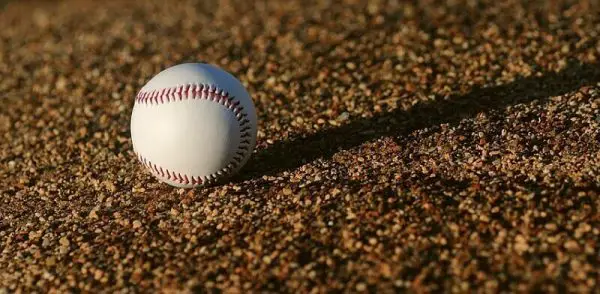For more than a century baseballs have been made essentially from simple cowhide rubber, some yarn, and cork. Even now as the world has advanced technologically with options like automation and synthetics, many baseballs used in leagues remain partially handmade.
Professional baseball players use baseball's that the Rawling company in Costa Rica have created by stitching cowhide on the inner cork.

But do they know the number of stitches on a baseball? A baseball has a total of 108 stitches. The ball makers hide the first and final stitches. All the stitches are hand down with a red thread waxed prior to use and measuring 88 inches.
The average length of time it takes to sew the external cowhide together (two figure-eight pieces) by hand is about 15 minutes. After this, the baseball is transferred to a rolling machine to smoothen the stitches still standing out. This is done for 15 seconds.
What is the Cost for New Baseballs Every Year?
Major league baseball spends a lot of fortune every year. Their major expenses come from purchasing every single ball that they require to play the 162 game season. The world series games and playoffs are often left out in this investment. In the major league, all the 30 major teams play many games summing the total in a season to 2430.
The baseball manufacturing company Rawlings makes around 80000 dozen baseballs for use in the league annually, simply put, 960000 balls.
The cost price of one of the balls is $6.79 and this implies that it costs the major league baseball a massive $8.56 million dollars in a year because they have to cater to popular demand.
Every year, more than 2000 games are played annually and there have to be as many balls as possible, and the explanation for this is given by statisticians. In a common nine-inning game, the average number of balls to be used is 100 balls and that means that for every game played, the league has to cough out more than $1000.00 to buy baseballs.
From experience, no baseball can last beyond six pitches in play, oftentimes they don't even play beyond the third pitch.
However, a baseball's short life span had a lot of reasons even though the buyers spent a fortune on it.
Why are Baseballs Replaced Over the Course of a Ballgame?
There are few reasons why the baseball's keep changing throughout the course of a baseball match:
- Foul Balls: if the ball is hit and it falls in the stands or the bat tips it off
- It touches dirt: if the surface of the ball is scratched with dirt from inside the field, it can cause it to have an offbeat movement
- Umpire’s discretion: when a ball hits the dirt, the umpire checks it for scratches and to find out if the pitcher made an intolerable modification to the ball like spitting on it
If after a ball has come in contact with infield dirt the umpire does not make the decision to change it, the pitchers can seize the opportunity to make scratches on the ball. When the surface of a ball is scratched, the trajectory of that ball changes, and its movement through the air becomes unusual and unnatural.
The consequence of this is that it is hard to hit or track. The baseballs that are used in every game are courtesy of the home team and when a match ends they use the scrap baseballs to practice batting in their practice matches.
How Is Baseball Made?
All the baseballs are made from simple materials. It consists of cowhide leather (which is what the top layer of the ball is made of), the yarn used to stitch the leather together, and a cork lined by rubber which makes up the ball's interior part. Another name for the rubber center and cork of the ball is ''pill."
Cutting a baseball into half will illustrate the layers of circles sharing the same center, with the rubber-lined cork as the core while surrounding it is two layers of cork.
To make a baseball, the very first thing to do is to coat the rubber-lined cork with two shells of black rubber shaped like a hemisphere. The two shells of black rubber contain red rubber casings inside of them.
The next step is to mold the exterior part of the black rubber hemispheres with one lump of red rubber.
This is how the pill is formed and it has to take a perfect fit circular shape without weighing up to an ounce.
When the pill has assumed the shape of a perfect circle, the next thing is to apply a thin film of cement on the surface. This is done to maintain the position of the wool yarn on the pill so it is not displaced when the cowhide is "wound" onto the surface of the ball.
The wool yarn used to do the "winding" must have been kept at a particular, constant humidity and temperature prior to use. The role of technology in the whole process is seen by the computerized winding machines used to provide a uniform rate of high tension for the sphere. The high tension removes any soft spot present in the ball and levels the surface.
While the process of winding is ongoing, the computer continuously weighs and measures the ball so that it remains in line with the stipulated requirements of the Major League Baseball size.
After that, the yarn is wrapped so tight around the ball until it looks like one fine thread. Every baseball is coated with three layers of wool.
The four-ply gray yarn wraps it first, the next is the three-ply white and another ios three-ply gray makes up the third layer. The entire layers of yarn can be as long as 200 yards when measured.
The winding process is brought to an end when the ball is wrapped with finishing yarn. One layer of 150 yards of a poly/cotton blend material is used to shield the wool yarn and keep it together. After that, a machine trims the tightly wound ball of surplus material. Then the application of a small film of adhesive on the surface is done to secure the cowhide exterior.
Stitching the Baseball Together
The baseball's surface is made from cowhide. The cowhide is divided into two, each having a figure 8 appearance and wrapping half of the baseball. After placing them, a temporal stapling is done.
Stitching the ball is a manual task because it has not been able to remain even when done with machines. To do this, the cowhide is soaked in a certain solution that softens it and makes it easy to reform.
When the two cowhide coverings are attached to the ball, it means it is time to sew them to the sphere. A worker does this with a waxed red thread. A total of 108, 88 inches of the thread is used to see the pieces of cowhide to the baseball.
The worker makes the initial and final thread totally invisible. It takes almost 15 minutes to carry out this last step of stitching by hand. After it is done, a rolling machine is used on the surface to roll over the ball.
An inspection is done and the Rawlings logo is put on the approved baseball's and shipped off to the league for their use.
Does the Way Modern Baseballs Are Made Affect Home Run Records?
There have been many theories from all over the world of sports both from followers of the game and those making science research in colleges all in a bid to find an explanation for the significant changes in the statistics of player's batting.
For instance, 2017 was crowned "season for hitters." Prior to that, Sammy Sosa and Mark McGwire in 1998 both shattered a record that Roger Maris had set in 1961 for the biggest number of home runs in one season that had 61 total home runs. Sosa played a total of 66 home runs while McGwire made it to 70.
This feat stirred up a controversy on whether there was steroid or drug use. A Congress investigation was carried out and the two players Sosa and McGwire confessed to being on steroids when they played in the 1998 season even though McGwire made a revelation that even during seasons when he hadn't broken any record, he still used steroids.
The record set by these two was broken by Barry Bonds in 2001 who hit 73 home runs in total and is the world record holder for the highest number of home runs in one season. He later confessed to using steroids just like the others.
During the 2017 season, players were screened thoroughly for using steroids and even though there was an all-time high in the number of home runs, none of it was attributed to drugs. The total number of home runs from hitters was a huge 6,105 that year, breaking all other existing records.
From research, there was evidence that indicated that the baseball manufacturers were making baseball's with little differences and that's the reason for more home runs and slugging, but the research did not get near completion.
The All-star break in 2015 ended and everyone noticed a change. The observation was that balls now fly a further range than before. In 2017, the USC school of medicine carried out a study and found out that the density of baseballs changed and so does the chemical composition of its center.
To add to that, the center of a modern baseball is not as dense as the former and their weight is half gram lower than the balls produced before 2014. According to the research, the baseballs produced from 2015 upwards bounced more and had lower air resistance than those used in the past.
Still, the supposed fluctuations in the buoyancy and weight of baseballs remain theories and some are still of the opinion that the little weight difference is the reason for the rise of home run output in the league. Some others assert that the improvement of the training and physical health of baseball players account for the increased home runs.
For a period of more than 150 years, baseball has existed as a known sport, still, there has been no decline in popularity. Out of all American sports, baseball is the one with the most fans.
Due to its early popularity, most people prefer it to other similar sports such as cricket. It is interesting to watch baseball because it has more aggressiveness compared to cricket and the batter keeps running as long as the ball is in the field, unlike cricket.
Although American baseball drew inspiration from cricket, it has become more popular than the latter.
Looking for more?
If you would like to read more, then we have hand picked some of our most popular pieces.
Information:
4 Seam VS 2 Seam Fastball – What’s the Difference?
Gamechanger VS iScore: Which Is Better For Baseball Scorekeeping?
Rules Of The Game: When Does Softball Season Start?
Equipment & Apparel:
Best Baseball Glove for 11 Year Old Boy
Best Baseball Glove For 9 Year Olds
Best baseball glove for infield and outfield
